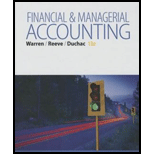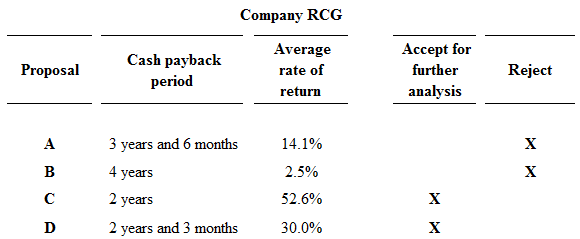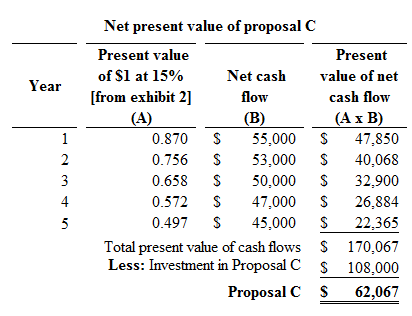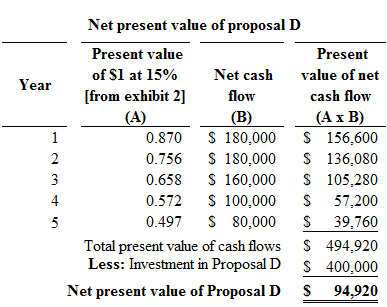
1.
Cash payback method:
Cash payback period is the expected time period which is required to recover the cost of investment. It is one of the capital investment method used by the management to evaluate the long-term investment (fixed assets) of the business.
Average
Average rate of return is the amount of income which is earned over the life of the investment. It is used to measure the average income as a percent of the average investment of the business, and it is also known as the accounting rate of return.
The average rate of return is computed as follows:
Net present value method is the method which is used to compare the initial
Present value index:
Present value index is a technique, which is used to rank the proposals of the business. It is used by the management when the business has more investment proposals, and limited fund.
The present value index is computed as follows:
The cash payback period for the given proposals.
1.
Explanation of Solution
The cash payback period for the given proposals is as follows:
Proposal A:
Initial investment=$680,000
| Cash payback period of Proposal A | ||||
| Year | Net cash flows | Cumulative net cash flows | ||
| 1 | 200,000 | 200,000 | ||
| 2 | 200,000 | 400,000 | ||
| 3 | 200,000 | 600,000 | ||
| 6 months (1) | 80,000 | 680,000 | ||
Table (1)
Hence, the cash payback period of proposal A is 3 years and 6 months.
Working note:
1. Calculate the no. of months in the cash payback period:
Proposal B:
Initial investment=$320,000
| Cash payback period of Proposal B | ||||
| Year | Net cash flows | Cumulative net cash flows | ||
| 1 | 90,000 | 90,000 | ||
| 2 | 90,000 | 180,000 | ||
| 3 | 70,000 | 250,000 | ||
| 4 | 70,000 | 320,000 | ||
Table (2)
Hence, the cash payback period of proposal B is 4 years.
Proposal C:
Initial investment=$108,000
| Cash payback period of Proposal C | ||||
| Year | Net cash flows | Cumulative net cash flows | ||
| 1 | 55,000 | 55,000 | ||
| 2 | 53,000 | 108,000 | ||
Table (3)
Hence, the cash payback period of proposal C is 2 years.
Proposal D:
Initial investment=$400,000
| Cash payback period of Proposal D | ||||
| Year | Net cash flows | Cumulative net cash flows | ||
| 1 | 180,000 | 180,000 | ||
| 2 | 180,000 | 360,000 | ||
| 3 months (2) | 40,000 | 400,000 | ||
Table (4)
Hence, the cash payback period of proposal D is 2 years and 3 months.
Working note:
2. Calculate the no. of months in the cash payback period:
2.
The average rate of return for the give proposals.
2.
Explanation of Solution
The average rate of return for the given proposals is as follows:
Proposal A:
Hence, the average rate of return for Proposal A is 14.1%.
Proposal B:
Hence, the average rate of return for Proposal B is 2.5%.
Proposal C:
Hence, the average rate of return for Proposal C is 52.6%.
Proposal D:
Hence, the average rate of return for Proposal D is 30.0%.
3.
To indicate: The proposals which should be accepted for further analysis, and which should be rejected.
3.
Explanation of Solution
The proposals which should be accepted for further analysis, and which should be rejected is as follows:

Figure (1)
Proposals A and B are rejected, because proposal A and B fails to meet the required maximum cash back period of 3 years, and they has less rate of return than the other proposals. Hence, Proposals C and D are preferable.
4.
The net present value of preferred proposals.
4.
Explanation of Solution
Calculate the net present value of the proposals which has 12% rate of return as follows:
Proposal C:

Figure (2)
Hence, the net present value of proposal C is $62,067.
Proposal D:

Figure (3)
Hence, the net present value of proposal D is $94,920.
5.
To determine: The present value index for each proposal.
5.
Explanation of Solution
The present value index for each proposal is as follows:
Proposal C:
Calculate the present value index for proposal C:
Hence, the present value index for proposal C is 1.575.
Proposal D:
Calculate the present value index for proposal D:
Hence, the present value index for proposal D is 1.237.
6.
To rank: The proposal from most attractive to least attractive, based on the present value of net cash flows.
6.
Explanation of Solution
Proposals are arranged by rank is as follows:
| Proposals | Net present value | Rank |
| Proposal D | $ 94,920 | 1 |
| Proposal C | $ 62,067 | 2 |
Table (5)
7.
To rank: The proposal from most attractive to least attractive, based on the present value of index.
7.
Explanation of Solution
Proposals are arranged by rank is as follows:
| Proposals | Present value index | Rank |
| Proposal C | 1.57 | 1 |
| Proposal D | 1.24 | 2 |
Table (6)
8.
To analysis: The proposal which is favor to investment, and comment on the relative attractiveness of the proposals based on the rank.
8.
Explanation of Solution
On the basis of net present value:
The net present value of Proposal C is $62,067, and Proposal D is $94,920. In this case, the net present value of proposal D is more than the net present value of proposal C. Hence, investment in Proposal D is preferable.
On the basis of present value index:
The present value index of Proposal C is 1.57, and the present value index of Proposal D is 1.24. In this case, Proposal C has the favorable present value index, because the present value index of Proposal C (1.57) is more than Proposal D (1.24). Thus, the investment in Proposal C is preferable (favorable).
Every business tries to get maximum profit with minimum investment. Hence, the cost of investment in Proposal C is less than the proposal D. Thus, investment in Proposal C is preferable.
Want to see more full solutions like this?
Chapter 25 Solutions
Bundle: Financial & Managerial Accounting, 13th + CengageNOWv2, 2 terms (12 months) Printed Access Card
- Please need answer the general accounting question not use aiarrow_forwardGroot Co. (GC) sells $1,200,000 of 6-year, 10% bonds at par plus accrued interest. The bonds are dated January 1, 2026 but due to market conditions are not issued until May 1, 2026. Interest is payable on June 30 and December 31 each year. The market rate of interest at time of issue is the same as the stated rate. Required The issuance of the bonds on May 1, 2026. Assume that GC has adopted a policy of crediting accrued interest payable for the accrued interest on the date of sale. Payment of interest on June 30, 2026. Payment of interest on December 31, 2026.arrow_forward1. Define working capital and explain its importance in financial health and liquidity management. 2. Assess how the matching concept and accrual basis affect the reporting of current assets and liabilities. 3. Using a hypothetical balance sheet (you may create one), identify at least 5 current assets and 5 current liabilities and analyze how changes in these elements affect liquidity ratios. 4. Recommend at least two strategies VinGrenDom Ltd. can implement to optimize working capital.arrow_forward
- Theron Interiors manufactures handcrafted cabinetry and uses a process costing system. During the month of October, the company started Production on 720 units and completed 590 units. The remaining 120 units were 60% complete in terms of materials and 40% complete in terms of labor and overhead. The total cost incurred during the month was $45,000 for materials and $31,200 for labor and overhead. Using the weighted-average method, what is the equivalent unit cost for materials and conversion costs (labor and overhead)?arrow_forwardGeneral Accountingarrow_forwardKamala Khan has to decide between the following two options: Take out a student loan of $70,000 and study accounting full time for the next three years. The interest on the loan is 4% per year payable annually. The principle is to be paid in full after ten years. Study part time and work part time to earn $15,000 per year for the following six years. Once Kamala graduates, she estimates that she will earn $30,000 for the first three years and $40,000 the next four years. Kamala's banker says the market interest for a ten-year horizon is 6%. Required Calculate NPV of the ten-year cash flows of the two options. For simplification assume that all cash flows happen at year-end. Based on the NPV which of the two options is better for Kamala?arrow_forward
 Managerial AccountingAccountingISBN:9781337912020Author:Carl Warren, Ph.d. Cma William B. TaylerPublisher:South-Western College Pub
Managerial AccountingAccountingISBN:9781337912020Author:Carl Warren, Ph.d. Cma William B. TaylerPublisher:South-Western College Pub Financial And Managerial AccountingAccountingISBN:9781337902663Author:WARREN, Carl S.Publisher:Cengage Learning,
Financial And Managerial AccountingAccountingISBN:9781337902663Author:WARREN, Carl S.Publisher:Cengage Learning, Survey of Accounting (Accounting I)AccountingISBN:9781305961883Author:Carl WarrenPublisher:Cengage Learning
Survey of Accounting (Accounting I)AccountingISBN:9781305961883Author:Carl WarrenPublisher:Cengage Learning EBK CONTEMPORARY FINANCIAL MANAGEMENTFinanceISBN:9781337514835Author:MOYERPublisher:CENGAGE LEARNING - CONSIGNMENTPrinciples of Accounting Volume 2AccountingISBN:9781947172609Author:OpenStaxPublisher:OpenStax College
EBK CONTEMPORARY FINANCIAL MANAGEMENTFinanceISBN:9781337514835Author:MOYERPublisher:CENGAGE LEARNING - CONSIGNMENTPrinciples of Accounting Volume 2AccountingISBN:9781947172609Author:OpenStaxPublisher:OpenStax College Intermediate Financial Management (MindTap Course...FinanceISBN:9781337395083Author:Eugene F. Brigham, Phillip R. DavesPublisher:Cengage Learning
Intermediate Financial Management (MindTap Course...FinanceISBN:9781337395083Author:Eugene F. Brigham, Phillip R. DavesPublisher:Cengage Learning





